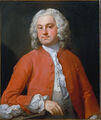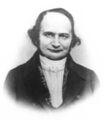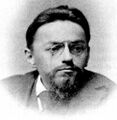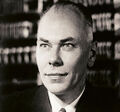Template:Selected anniversaries/October 26: Difference between revisions
No edit summary |
No edit summary |
||
| Line 1: | Line 1: | ||
<gallery> | <gallery> | ||
||1689 | ||1689: General Piccolomini of Austria burns down Skopje to prevent the spread of cholera. He died of cholera himself soon after. | ||
File:William Hogarth.jpg|link=William Hogarth (nonfiction)|1764: Satirist, painter, illustrator, and critic [[William Hogarth (nonfiction)|William Hogarth]] dies. His work ranged from realistic portraiture to comic strip-like series of pictures called "modern moral subjects". | File:William Hogarth.jpg|link=William Hogarth (nonfiction)|1764: Satirist, painter, illustrator, and critic [[William Hogarth (nonfiction)|William Hogarth]] dies. His work ranged from realistic portraiture to comic strip-like series of pictures called "modern moral subjects". | ||
||Samuel Klingenstierna | ||1765: Samuel Klingenstierna dies ... mathematician, scientist, and academic. He was instrumental in the invention of the Achromatic Telescope. Pic. | ||
||1773 | ||1773: Amédée-François Frézier dies ... mathematician, engineer, and explorer. | ||
||1776 | ||1776: Benjamin Franklin departs from America for France on a mission to seek French support for the American Revolution. | ||
||1817: Aida Yasuaki dies ... mathematician in the Edo period. He made significant contributions to the fields of number theory and geometry, and furthered methods for simplifying continued fractions. Pic. | |||
File:Carl Gustav Jacob Jacobi.jpg|link=Carl Gustav Jacob Jacobi (nonfiction)|1848: Mathematician and crime-fighter [[Carl Gustav Jacob Jacobi (nonfiction)|Carl Gustav Jacob Jacobi]] publishes landmark paper on the application of elliptic functions to the computation and prevention of [[crimes against mathematical constants]]. | File:Carl Gustav Jacob Jacobi.jpg|link=Carl Gustav Jacob Jacobi (nonfiction)|1848: Mathematician and crime-fighter [[Carl Gustav Jacob Jacobi (nonfiction)|Carl Gustav Jacob Jacobi]] publishes landmark paper on the application of elliptic functions to the computation and prevention of [[crimes against mathematical constants]]. | ||
| Line 14: | Line 16: | ||
File:Georg Frobenius.jpg|link=Ferdinand Georg Frobenius (nonfiction)|1849: Mathematician and academic [[Ferdinand Georg Frobenius (nonfiction)|Ferdinand Georg Frobenius]] born. He will make contributions to the theory of elliptic functions, differential equations, and group theory. | File:Georg Frobenius.jpg|link=Ferdinand Georg Frobenius (nonfiction)|1849: Mathematician and academic [[Ferdinand Georg Frobenius (nonfiction)|Ferdinand Georg Frobenius]] born. He will make contributions to the theory of elliptic functions, differential equations, and group theory. | ||
||1874 | ||1874: Martin Lowry born ... chemist and academic. | ||
||Shiing-Shen Chern | ||1911: Shiing-Shen Chern born ... mathematician who made fundamental contributions to differential geometry and topology. He was widely regarded as a leader in geometry and one of the greatest mathematicians of the twentieth century. | ||
File:Heike Kamerlingh Onnes.jpg|link=Heike Kamerlingh Onnes (nonfiction)|1922: Physicist and crime-fighter [[Heike Kamerlingh Onnes (nonfiction)|Heike Kamerlingh Onnes]] publishes breakthrough survey of applications of matter at low temperatures to the computation and detection of [[crimes against mathematical constants]]. | File:Heike Kamerlingh Onnes.jpg|link=Heike Kamerlingh Onnes (nonfiction)|1922: Physicist and crime-fighter [[Heike Kamerlingh Onnes (nonfiction)|Heike Kamerlingh Onnes]] publishes breakthrough survey of applications of matter at low temperatures to the computation and detection of [[crimes against mathematical constants]]. | ||
| Line 24: | Line 26: | ||
File:Clock Head 2.jpg|link=Clock Head 2|1923: [[Clock Head 2]] remembers mathematician and electrical engineer [[Charles Proteus Steinmetz (nonfiction)|Charles Proteus Steinmetz]] as "a genius, and a true friend." | File:Clock Head 2.jpg|link=Clock Head 2|1923: [[Clock Head 2]] remembers mathematician and electrical engineer [[Charles Proteus Steinmetz (nonfiction)|Charles Proteus Steinmetz]] as "a genius, and a true friend." | ||
||1930 | ||1930: Waldemar Haffkine born ... physician and microbiologist. | ||
||1936 | ||1936: The first electric generator at Hoover Dam goes into full operation. | ||
File:Alexey Krylov 1910s.jpg|link=Aleksey Krylov (nonfiction)|1945: Mathematician and naval engineer [[Aleksey Krylov (nonfiction)|Aleksey Krylov]] dies. Fame came to him in the 1890s, when his pioneering theory of oscillating motions of the ship became internationally known. | File:Alexey Krylov 1910s.jpg|link=Aleksey Krylov (nonfiction)|1945: Mathematician and naval engineer [[Aleksey Krylov (nonfiction)|Aleksey Krylov]] dies. Fame came to him in the 1890s, when his pioneering theory of oscillating motions of the ship became internationally known. | ||
||1957 | ||1957: Gerty Cori dies ... biochemist and physiologist, Nobel Prize laureate. | ||
||Sergei Natanovich Bernstein (d. 26 October 1968) was a Russian and Soviet mathematician of Jewish origin known for contributions to partial differential equations, differential geometry, probability theory, and approximation theory. Pic. | ||Sergei Natanovich Bernstein (d. 26 October 1968) was a Russian and Soviet mathematician of Jewish origin known for contributions to partial differential equations, differential geometry, probability theory, and approximation theory. Pic. | ||
| Line 46: | Line 48: | ||
File:Alfred Tarski 1968.jpg|link=Alfred Tarski (nonfiction)|1983: Mathematician and philosopher [[Alfred Tarski (nonfiction)|Alfred Tarski]] dies. He was a prolific author, contributing to model theory, metamathematics, algebraic logic, abstract algebra, topology, geometry, measure theory, mathematical logic, set theory, and analytic philosophy. | File:Alfred Tarski 1968.jpg|link=Alfred Tarski (nonfiction)|1983: Mathematician and philosopher [[Alfred Tarski (nonfiction)|Alfred Tarski]] dies. He was a prolific author, contributing to model theory, metamathematics, algebraic logic, abstract algebra, topology, geometry, measure theory, mathematical logic, set theory, and analytic philosophy. | ||
||Mark Kac | ||1984: Mark Kac dies ... mathematician. His main interest was probability theory. His question, "Can one hear the shape of a drum?" set off research into spectral theory, with the idea of understanding the extent to which the spectrum allows one to read back the geometry. (In the end, the answer was "no", in general.) Pic. | ||
|| | ||1989: Charles J. Pedersen dies ... chemist and academic, Nobel Prize laureate. | ||
| | ||1998: Kenkichi Iwasawa dies ... mathematician and academic ... known for his influence on algebraic number theory. | ||
| | ||2001: The United States passes the USA PATRIOT Act into law. | ||
| | ||2002: Moscow theater hostage crisis: Approximately 50 Chechen terrorists and 150 hostages die when Russian Spetsnaz storm a theater building in Moscow, which had been occupied by the terrorists during a musical performance three days before. | ||
| | ||2007: Arthur Kornberg dies ... biochemist and academic, Nobel Prize. | ||
| | ||2008: Martin Arthur Pomerantz dies ... physicist who served as Director of the Bartol Research Institute and who had been a leader in developing Antarctic astronomy. | ||
| | ||2015: Leo Kadanoff dies ... physicist and academic. | ||
| | ||2015: S. Barry Cooper dies ... mathematician and computability theorist. His book ''Computability Theory'' made the technical research area accessible to a new generation of students. Pic. | ||
</gallery> | </gallery> | ||
Revision as of 10:45, 4 September 2018
1764: Satirist, painter, illustrator, and critic William Hogarth dies. His work ranged from realistic portraiture to comic strip-like series of pictures called "modern moral subjects".
1848: Mathematician and crime-fighter Carl Gustav Jacob Jacobi publishes landmark paper on the application of elliptic functions to the computation and prevention of crimes against mathematical constants.
1849: Mathematician and academic Ferdinand Georg Frobenius born. He will make contributions to the theory of elliptic functions, differential equations, and group theory.
1922: Physicist and crime-fighter Heike Kamerlingh Onnes publishes breakthrough survey of applications of matter at low temperatures to the computation and detection of crimes against mathematical constants.
1923: Mathematician and electrical engineer Charles Proteus Steinmetz dies. He fostered the development of alternating current, formulating mathematical theories which advanced the expansion of the electric power industry in the United States.
1923: Clock Head 2 remembers mathematician and electrical engineer Charles Proteus Steinmetz as "a genius, and a true friend."
1945: Mathematician and naval engineer Aleksey Krylov dies. Fame came to him in the 1890s, when his pioneering theory of oscillating motions of the ship became internationally known.
1969: Physicist and computer scientist Howard H. Aiken publishes new class of Gnomon algorithm functions which compute and prevent crimes against mathematical constants.
1972: Aircraft designer Igor Sikorsky dies. He pioneered both helicopters and fixed-wing aircraft.
1972: Space pilot and alleged time-traveller Henrietta Bolt remembers aircraft engineer Igor Sikorsky as "a genius, and a true friend."
1983: Mathematician and philosopher Alfred Tarski dies. He was a prolific author, contributing to model theory, metamathematics, algebraic logic, abstract algebra, topology, geometry, measure theory, mathematical logic, set theory, and analytic philosophy.










